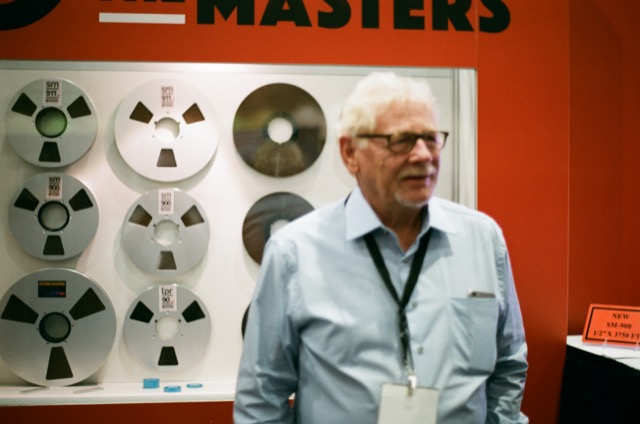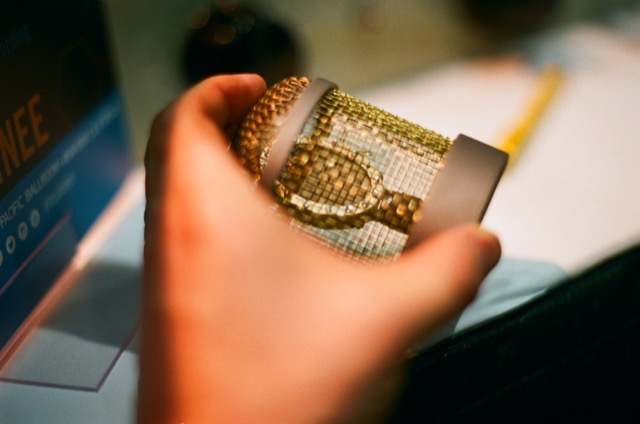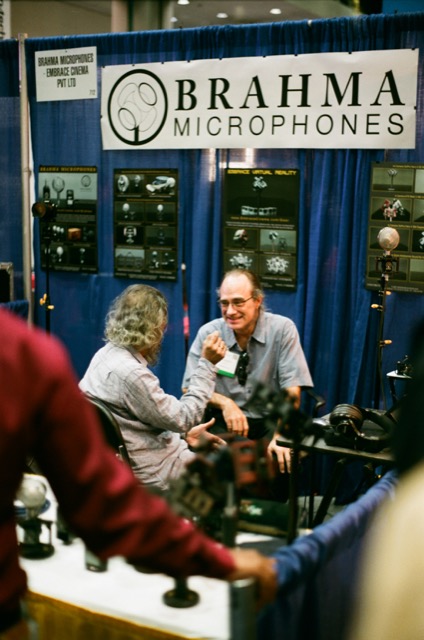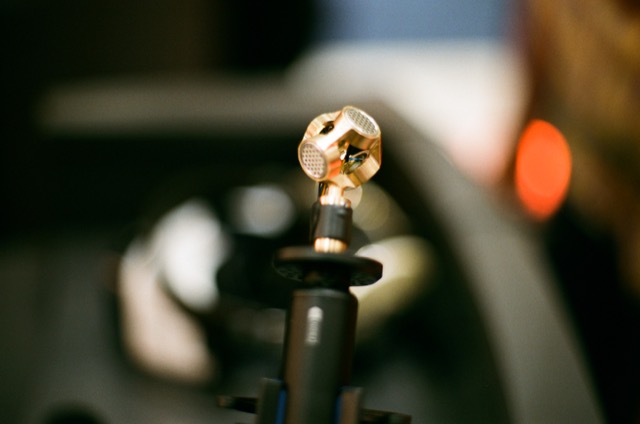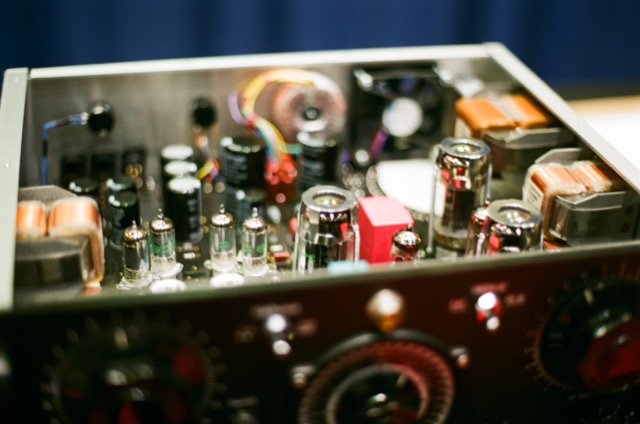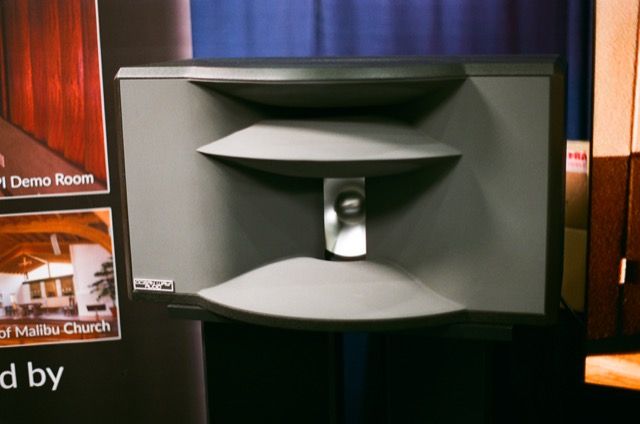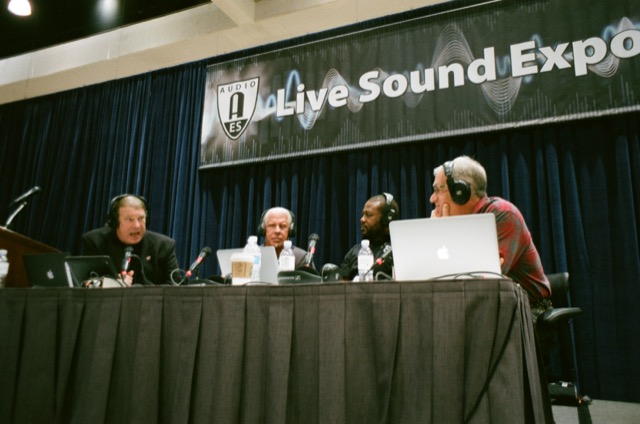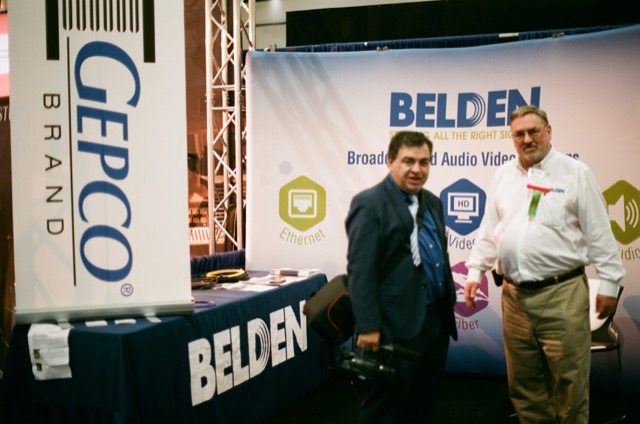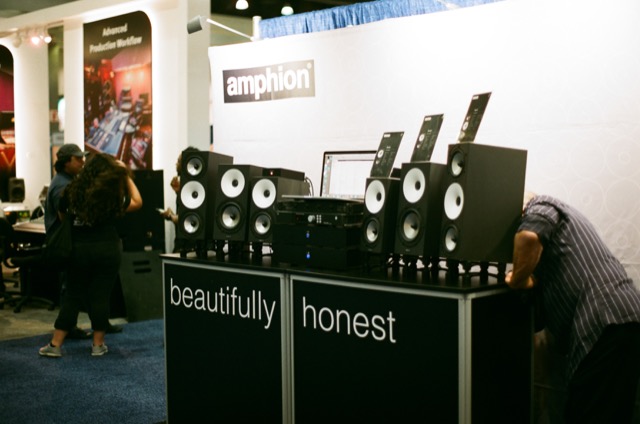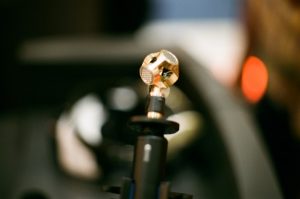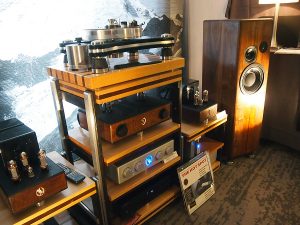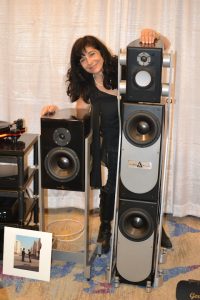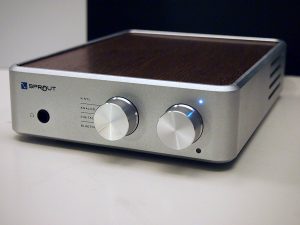The Audio Engineering Society puts on a convention in the US every year, and what makes it most interesting is that traditionally it has been both a trade show and a scientific conference with formal papers, both in the same building at the same time. This makes it more interesting than other trade shows, because the engineers that know the theory are there (even if they aren't in the booth all the time because they are down listening to papers). For the same reason it's more interesting than other conferences because you can see and touch actual hardware there.
A lot of the technology being discussed is stuff that will be important in home audio a few years from now, and a lot of it is old technology that people are refining, and some of it is in-between, and that's another reason why I enjoy the convention so much.
This is basically my recap of what I saw at the show and what I liked. I try to identify stuff that is interesting to a high end audio audience, but there is just so much at the show that I miss a lot of it. For example, there was a panel about subjective listening vs. objective measurements and I didn't make it because I was booked for something else at the time. I try and talk about what is new, but when I do people often tell me that that thing is years old and I had missed it at previous shows.
So, think of this as just things I liked. I was kind of disappointed at the reduced number and quality of papers this year, with a lot of paper tracks completely gone or rolled into some other track. On the other hand, there were more and better workshops and tutorials than ever before, perhaps some of them being items that would in previous years have been shown as papers. The trade show section is much smaller than it used to be, but that means more opportunity to actually see things.
Media
The old BASF formula magnetic tapes that were sold by RMGI in Holland for many years have been taken over by Pyral which is selling them under the name "Recording The Masters." RMGI-USA is still selling them in the US, along with a large line of other products including some solid-looking portable hard drives.
AES Magnetics also had a booth selling their fine magnetic tape, much higher output than anything else being made today.
On the subject of long-term media storage, there was a tour of the Iron Mountain storage facility in LA which is being used by studios and artists for long-term storage of their work. But they made me sign an NDA that is restrictive enough that I can't tell you why it was so cool a tour. I can only tell you that it was cool and you should feel bad for having missed it.
Microphones
The guys from micparts.com were there, showing off a wide variety of individual microphone parts available in small quantitities for home builders wanting to make replicas of classic designs.
Josephson Engineering and PCB Piezotronics were showing off measurement microphones of various sorts, and Josephson was also showing their usual line of high end studio microphones for a variety of applications.
Bock Microphones was showing their 507 microphone, a large diaphragm ribbon condenser with an elliptical capsule. It seemed to have a good narrow pattern but it still worked well when worked close as a vocal mike. What are the basic physics of the elliptical design? Does anyone know? The idea is a fascinating one and the prospect of breaking resonant modes up across a variety of frequencies seems like a good one with a future.
And Wes Dooley of AEA was showing their N-22 miniature ribbon microphone. Yes, it's a ribbon mic with a good ribbon null, but also with some top end extension.
Samar Audio Labs, which makes a variety of very clean ribbon microphones, is selling a new model condenser microphone. It was so new, they didn't even have a part number on the thing. Mark Fouxman of Samar puts a lot of work into good acoustical design so this is likely to be worth checking out under better auditioning conditions than are available at the show.
It seemed like this was the year for ambisonic microphone arrays intended for the virtual reality market. So much of the virtual reality software is designed to accept a soundfield recorded with ambisonic methods, so both A-format and B-format ambisonic microphones have been a big item.
Brahma Microphones, a company from Uttar Pradesh in India brought in a very nicely-made line of ambisonic microphones, as well as a retrofit kit for one of the Zoom recorders that would permit direct ambisonic recording in the field with an internal microphone. The system looks like a good one and it's one anybody looking into ambisonics should investigate. They have created their own microphone connector format with an M-S connector, however, adding a bit to the confusion in the field about cabling.
Sennheiser was also showing off an ambisonic microphone, the Ambeo VR Mike, which produces A-format output. There wasn't anyone there that knew much about it but once Sennheiser gets into the market you know there is something to it.
Dysonics was showing their Rondomic, a slightly oblate sphere with omni capsules around the equator. Much like the original Schoeps sphere but with an array of eight capsules. It's hard to tell what this really is, as they describe it as producing multiple binaural sound fields but without pinna replicas it cannot produce most of the binaural cues. Again aimed at the virtual reality market. Whereas for conventional surround systems, rear imaging is not important because we don't hear great localization behind us, for virtual reality applications the head might be in any position and so a full 360 degree soundfield is needed.
There were fewer microphone papers this year, but the ones that did get presented were interesting. In Development of shotgun microphones with extra-long leaky tube, Yo Sasaki, and others from NHK and Sanken Microphones present a good mathematical model for the shotgun microphone which well describes both directionality and internal resonances and find that it fits well with the actual behaviour of their test microphone and a reference shotgun microphone. Preprint 9639.
Chinese Food
So, Steve Lampen from Belden invited me out for Chinese food and after some negotiations and fiddling with websites I suggested a place called Chengdu Taste which had been recommended to me by several people but was really too far out of the downtown area for me to visit without a car. Steve had a car and was happy to drive and he was so hungry he just acquiesced without thinking about the consequences of the name. So we get there and we sit in line for some time because it appears to be a very popular place and only when we actually start ordering does he inform me that he doesn't like hot food. And, I have to say that I love hot food but some of the food was too hot for me. It was excellent, but it was too hot.
Microphone Stands
This year it seemed like there were nearly as many microphone stands as microphones out there, which is a big deal to my mind because microphones need stands.
AEA was showing off some very ingenious folding stands for field recording applications, very light but solid.
On the exact other end of the spectrum, the drum company Tama was showing off some stage mike stands, which weighed a bit more and and were far more stable than any music store stands. Perhaps a bit heavy for concert use, they look to be just the thing for the studio where rigidity is critical and where squeaks and groans from cheap stands are a nightmare.
Latch Lake also had a device called the "Retro Boom" which was a heavy and solid mike boom that screwed into the shaft and base of the older Atlas round-base microphone stands. A lot of studios have those old Atlas stands sitting around in the closet; they are so well made it is a shame to get rid of them and these booms make them far more versatile and useful. Latch Lake has long had a line of studio stands; too heavy for concert use but smaller and far more convenient than the big Hollywood and Starbird booms.
Triad-Orbit was selling stands with ball-mount fixtures that could swivel in any direction and lock into place. Again this provides a measure of convenience you don't get with conventional booms.
Processors
Possibly one of the most exciting things in the show is that Manley Labs is finally making a variable-mu compressor using readily available 6BA6 tubes rather than weird NOS exotica. The Nu Mu compressor looks to be an lower cost and more maintainable alternative for studios looking for the kind of thickness and density that this sort of compressor can give. Although the output stage is solid state, the input and compression are tube, making a reasonable hybrid design. Look in these pages soon for a Nu Mu Review.
Interestingly enough, Electronaut was also showing off their M97 compressor, which was also based on a 6BA6 variant, the 5749. Very retro styling but a simple and clean audio path.
Dan Dugan was showing off more automatic mixing devices for panels and talk shows, gadgets which are faster on the fader than a human being can be and which can offload some of the work of complex spoken word mixes. His new Model M and Model N can integrate with an existing digital console using MADI or Dante, and can be controlled with either a laptop or their own control panel, the Model K. If you have heard any major TV network talk shows, you have heard one of these at work and the newer models give more seamless integration and the prospect of being able to work with future consoles years from now due to the standardized interfaces.
Converters
Lavry, manufacturer of some of the best studio-grade A/D and D/A converters out there, is now making a high-accuracy reference clock. This is a big deal for studios that have a lot of equipment working together which all needs to share a central clock reference, and doing it with low jitter is hard.
The folks from Neatmic were selling a weird conical device with a 12AX7 in the top of it that was a 96 ksamp/sec converter and a headphone preamplifier. Is it any good? Is the tube actually doing anything important? You can't tell these things at the show but it was definitely the sort of thing that would have a market in the high end headphone listening community. I know nothing about Neatmic other than that they employ Martins Saulspurens the great Latvian microphone expert, but that's a huge point in their favour.
Consoles
There were a lot of new mixing consoles out there but what most interested me this year was an old thing. Cadac had a big demo room showing off their sound reinforcement consoles. In the US, Cadac consoles are mostly used in the Broadway and touring stage world, and they are relatively unknown in the music industry. This is a shame because they make digital consoles that don't lead you through a horrible array of menus trying to find simple functions. But, it turns out that they actually still make analogue consoles. They don't have them at the shows, but they still make them and you can still order a big J-type or a little S-type analogue console off the shelf today.
THD Labs was selling the Tangerine Automation Interface, which replaces the 1970s vintage General Automation minicomputer that is used for automation on the earlier SSL consoles, with a modern PC-based system. A big deal for keeping those older consoles going.
Oh, and JamRacks was selling bamboo studio furniture... stuff to put your console on and racks to put equipment into as well. Very modern-looking and very convenient-looking too.
Monitor Speakers
One of the more interesting things that I heard was the new Dynaudio M5P monitor speaker. These are voiced rather differently than the traditional Dynaudio products, and they are designed to be listened to at normal levels rather than exaggeratedly loud use. In the terrible room they had for demos it was hard to get a sense of what they really sounded like but they seemed balanced and worth investigating. These are tall floor-standing systems, something else that seems increasingly rare today.
PSI Audio was showing off their A17-M mini-monitor. This is a Swiss speaker company without a big customer base in the US, but which has made some very clean speakers and I want to give them credit for being one of the very few monitor companies that actually gives realistic measurements of their products. Not as much information as you'd need to get a real sense of performance, and no EASE files for modelling control rooms, but it's certainly a start.
Neumann had a demo room set up with their excellent line of monitor speakers derived from the old Klein and Hummel designs, but the two times I went in over the weekend the demos were being cancelled for some reason. Oh, well.
Likely better than JBL which was showing their fabulously clean M2 reference monitor in a completely untreated room with massive top end problems in the rear. It is so painful to me when you take such a great product and do such a poor job of showing it off.
Peerless/Tymphany was showing off their line of high end speaker drivers intended for home audio and for studio monitor applications. They make just about everything.
And another monitor-related thing: NTP Technology, makers of some very fine converters and some of the best DSD converters out there, is selling now a box called the "Pro Mon 2." This is a computer-controlled monitor controller, more or less like a digital line stage on steroids. Select your digital input, your level, your speaker configuration and it goes. Got a mono, stereo, or 5.1 source? You can route them all, along with dozens of other formats like ATMOS.
A few years ago, Juha Backman was working for Nokia and doing some very interesting research into nonlinearity of air through restricted tubes like the entrances to electret microphone capsules. Now, in Fluid Dynamics Analysis of Ported Loudspeakers he is doing CFD analysis of some simple ported loudspeaker boxes to visualize flow around the port itself and investigate how nonlinear effects are caused by turbulence and the compressibility of air. It's far from a usable model at this point but the preliminary work is very interesting. Preprint 9617.
Sound Reinforcement
After many years with very few sound reinforcement vendors at the show and really no PA speakers on display at all, things have turned around and there was a lot more out there this year.
Alcons Audio, one of the few companies selling ribbon speakers for sound reinforcement, was there. They were showing some big line array systems, but also some portable boxes-on-sticks devices and some boxes intended for cinema sound. These systems have evolved from the older Stage Accompany designs of the eighties which I liked a lot, and the new Alcons gear is just as clean and has even better power handling.
L-Acoustics is the company that pretty much invented the large scale line array. Their name is so synonymous with line arrays that this year they were giving out data sheets that didn't even have the company name on it. Their new Kiva II system is a miniaturized line array with small cabinets that is suitable for small rooms as well as for things like festival tents where the directional control of a line array is a lifesaver.
Nexo, a division of Yamaha, was also showing off their ID system, another smaller line array that would be perfect for festival jobs, large churches, and the like.
KV2 Audio is a Czech company that hasn't been seen a lot out here, and they were showing off some line array systems as well as some smaller portable PA gear. (They also had a line of electronics as well but didn't have much of that on display). Their VHD 5.0 point source array is an interesting take on arrays for large venues.
Interestingly, the folks from BOSE were there. These guys have some big line array systems and are trying to get into that market. It's a crowded place to be, and while BOSE In the past has had excellent engineering they have not applied it toward good sound quality. So it will be very interesting to see how they do; I know they have been in the pro audio market (and by that I mean actual pro audio and not the stuff sold in music stores) for some time but with little real market penetration. So it's good to see them at the show.
There was a lot of large venue gear this year, something that has been missing from the show for a long, long time. It only there was a space to properly audition it all.
In Power Considerations for Distortion Reduction of Loudspeakers, Ajay Iyer, Doug Button, and Russ Lambert from Harman International looked at using nonlinear models of loudspeakers for distortion reduction, versus using a lower distortion driver, and found that although power requirements weren't an issue that the added cost of the distortion reduction were greater than the costs of an improved driver. This was working with mid-grade drivers and the results may be different on the higher end of the market where driver improvements may be more difficult, but the overall paper was an interesting look into the sort of cost-optimization that engineering commercial products is about. Preprint 9605.
Headphones
Considering the huge explosion in headphones in the consumer world, I was surprised not to see as big an increase in research on making headphones better.
But, in Non-Traditional Noise and Distortion Sources in Headphones and Earbuds and the Impact on System Performance and Ear Fatigue, Dennis Rauschmeyer talked about two interesting distortion mechanisms. First he talked about "ghost current" which was his way of talking about nonlinear impedance of the driver caused by reflections from inside the ear, and then in addition he talked about distortion caused by external noise being picked up as microphonics by the driver. It would strike me that both of these problems could be readily eliminated by driving with a very low source impedance that would swamp any returned current from the earphone, but the author talked about a proprietary system to reduce these issues. There was an additional discussion about ear fatigue which was actually more interesting to me than the rest of the paper. Preprint 9640.
Loudness
Talking both about about loudness and headphones, Hyper-Compression, Environmental Noise and Preferences for the Ear Bud Listening Experience was presented by Robert Taylor and Luis Miranda from Australia. The authors say that high levels of compression and limiting are promoted on the grounds that they improve listening under high noise environments and they set out to see if this was actually the case by providing listeners with a replicated noisy environment combined with lightly compressed or highly compressed and limited audio. They found that the listeners in fact had no real preference for or against hypercompression. Preprint 9657.
On a totally different loudness note, it's important to have slow gainriding compression for broadcast so that overall perceived levels remain uniform, but at the same time it's also important not to clip. There have been numerous approaches to this problem in the past century, but a new one is shown in A two-pass algorithm for automatic loudness correction by Alexy Lukin and others at Izotope. They take in the whole program at once, do an analysis pass on it to determine loud and soft passes, and then after doing calculation they make a second pass to adjust the levels. The analysis is done with a perceptual model related to BS.1770 to estimate just how loud things sound to the listener, rather than just using a moving average like a conventional compressor. Preprint 9683.
As part of the Broadcast and Streaming Media track, Marvin Caesar led a distinguished panel of experts on the subject of Listener Fatigue and Retention. There was a lot of discussion on loudness-induced fatigue as well as some talk of fatigue due to compression artifacts, but while there was some discussion of psychoacoustics and the mechanisms of hearing fatigue at high levels, there was no discussion about the central source of the problem, that fatigue is caused by lack of clarity and that anything that forces listeners to have to work hard (be it excessive distortion or the loss of high end as the ears shut down at high levels) makes the problem worse.
Surround
David Miles Huber, a dance music producer, gave a talk entitled Engineering IDM in 5.1 which was a fascinating look at a totally different approach toward using surround. In addition, he talked a bit about higher speaker count systems like AURO, and doing the talk in PML's demo room made it possible to do excellent playback. His approach of building a mix around the listener rather than recreating a performance is totally different than mine, such a dramatically different approach. And that, in the end, is really what the AES show is about.
Grateful Dead concerts have long been recorded by amateur tapers, and in Grateful Live: Mixing Multiple Recordings of a Dead Performance into an Immersive Experience, Thomas Wilmering, Florian Thalmann, and Mark B. Sandler from the UK describe software that can perform feature detection on multiple recordings made at the same concert, line them all up, and produce a combined surround recording assembled from multiple sources. The end result in the demo was really quite interesting and the method was a fascinating exercise in correlation. Preprint 9614.
In A Three-Dimensional Orchestral Music Recording Technique Optimized for 22.2 Multichannel Sound, Will Howie, Richard King, and Denis Martin describe a method for making direct concert recordings for playback in 22.2 format. They use a spaced array of direct microphones near the stage combined with an array of surround microphones farther back in the hall, but what is most interesting is that they find the "bottom" channels intended to convey height in the room for film effects actually made a substantial improvement in perceived sound quality and in the perception of the hall. Preprint 9612.
In Music Production for Dolby Atmos and Auro 3D, Dr. Robert Jay Ellis-Geiger gave a good overview of some production techniques that people are starting to use in mixing for object-based audio systems. Not any new research, but both a summary of published research on miking and mixing techniques and some personal experiences and techniques with these systems. Very worthwhile for anyone interested in any of these new reproduction techniques. Preprint 9675.
A really different application for multi-speaker object-oriented audio was described in A Real-Time Simulation Environment for use in Psychoacoustic Studies of Aircraft Community Noise. The Exterior Effects room at NASA is a listening room with a large speaker array including an overhead array which is used to playback aircraft sounds (made with amplitude panning) for subjective evaluation of noise on the ground. To this end, the speaker positions must be compensated for and equalization performed to compensate for boundary issues and make sure the response at listening positions is flat. The authors, Kenneth John Faller II, Stephen A. Rizzi, and Aric R. Aumann, performed measurements on the room and constructed Weiner FIR filters to equalize response, but found that the required computational power was excessive for real time use. They then constructed conventional IIR filters with similar response, compared them with that of the FIR filters, and then measured the room with each to find good performance with the simplified filter. This work has applications in all manner of high order playback environments. E-Brief 305.
Sound for Film
I found the sound for film track a bit disappointing this year, with a small number of people being tapped for many program items. I was surprised that, given that it was Los Angeles, they were not able to bring more interesting speakers in. One thing that was interesting, though, was "Music Scoring for Film and TV: How it Was, Where it Is, Where It's Going", a panel with a number of people but which in many ways seemed to be carried by Leslie Ann Jones from Skywalker Sound, and by Jason LaRocca who described the exact opposite end of the market for television broadcast, and listening to the two of them was worth the price of admission. I only wish the moderator, Brian McCarthy, was able to get the two of them talking together more about techniques as well as work environments.
Room Treatment
There were a lot of vendors I didn't have any chance to visit.
Diffuse by Listen was a new company selling all manner of ingenious diffusers of different configurations and materials.
WhisperRoom was showing off sound isolation enclosures that were so popular with people trying to get some respite from the noise of the show floor that I didn't even get a chance to try them. Clearly they worked or people would not have been hogging them!
Recorders
Surprisingly most of the usual suspects from the sound-for-film world weren't there this year. Nagra was, though, showing off their elegant and clean line of portable recorders that are just as rugged and accurate as the old analogue systems. The Nagra Seven is a two-channel over-the-shoulder SD card recorder that actually has good mic preamps built it and controls that you can operate with gloves on in the field. Somebody thought about this stuff before building it.
On the other end of the market, Astell and Kern, who are somewhat famous in the high end world for making high grade portable audio players, have gone into the digital recorder market with the AK Recorder, a pocket-sized device with proper balanced inputs and 48V phantom power at a far lower price point than the typical film system gear, but with some effort put into getting good sound quality.
Power Amplifiers
With the great increase in the use of powered speaker designs both for studio and live applications, we're seeing fewer and fewer standalone power amps out there. There's still a need for them, and Benchmark Media was showing off a new one. It's not so new that it hasn't already got a couple awards, though. The AHB2 is definitely worth checking out if you're looking for a quiet and clean power amp.
Parts
Profusion had a booth: this is a dealer in the UK which specializes in a large range of different semiconductors for the audio industry as well as some other components like resistors. I was surprised to see them at an American show but very pleased if only because they seem to go out of their way to find new and interesting audio products. This year what most caught my eyes were the MUSE op-amps from New Japan Micro.
Electroswitch had a booth but nobody arrived to man it; it just sat empty for the whole show. Which is a shame since I wanted to talk to them again about multipole toggle switches.
Folks from Schurter were there showing off fuses, input modules, and power connectors. This is another European company that makes commodity components to very high precision, without a lot of publicity in the US.
Anaview were showing off class D amplifier modules that drop into new or existing products. Want to make a receiver? Want to make a powered speaker? These guys have a power stage that will drop right in. Do they sound good? I have no idea but there are certainly plenty of applications out there.
A company called NBC Electronic Technologies Company, headquartered in Guangdong but with a representative in New Jersey, was showing a variety of headphone parts. These included all manner of different headband and cup parts as well as trim pieces. Just about everything but the driver was available as individual parts.
Another interesting and new company, Belleson, was showing off small discrete regulator boards that were drop-in replacements for inexpensive TO220 regulators, but with much lower output impedance for stiffer supplies. An easy upgrade for a lot of equipment as well as a product worth designing into new equipment. Belleson also makes custom regulators for new products as well, including high voltage regulators for tube B+ supplies.
Associations
Lots of other associations were out on the show floor, including the Women's Audio Mission, the Society for Broadcast Engineers, the OCA Alliance (a group sponsoring a standard for audio networking), the Society of Professional Audio Recording Services, and probably a lot of others I have forgotten. All good folks who come out and support the show and who should themselves be supported.
Virtual Reality
This year the show was co-located with the Audio for Virtual and Augmented Reality conference, and it was interesting to watch the crossover between the two groups. I did stick my head into a couple of the presentations and I was pleased to see some systematic study being done into immersive audio and video presentation.
There were some vendors associated with that conference as well, such as Gaudio which provides software that takes a mixture of ambisonic audio sources (3D sound fields) as well as audio objects (an audio stream with a source position) and puts them into a room-and-head simulator to produce a binaural output that moves the sources around as the listener moves his head.
One booth, though, had an application of virtual reality to audio rather than the other way around. Audio Fusion was showing a virtual studio where you could put on the VR helmet and walk around the studio, operating the console, some outboard devices, and a patchbay. There was a tape machine there but you couldn't actually cut the tape on it. I'm not sure how effective this is for studio training but it's certainly an interesting idea and I certainly had fun playing around with it.
Cables
Not a cable at all, but I'm going to list it here because it replaces one is the Xirium Pro system from Neutrik. This is a two-channel digital audio link on the 5 GHz ISM band, with a good long range and input modules for analogue audio, Dante, or even AES/EBU. A great solution for running delayed speakers at an outdoor festival, or hopping audio out from the stage to speakers in a dressing room or entrance area, or even for limited remote broadcast applications. It fills up the mid-distance area between a short wireless microphone and a long satellite or microwave link.
Either the best cable news or the worst cable news of the year is that Belden, which manufactures the largest variety of cables you can imagine, has bought out Gepco, which manufactured high quality but inexpensive audio and video cables. It's good in that without Belden having stepped in, likely Gepco would have dropped completely off the face of the earth. It's bad in that now there will be one fewer supplier competing for bids on cables. Belden is promising to keep the Gepco products in production although they will be making them in a Belden plant. They say they are going to try to keep the prices as low as Gepco's original prices although of course that remains to be seen (and if Gepco were making a lot of profit they likely wouldn't have collapsed in the first place).
Gadgets
Lundahl Transformers has been around for the good part of a century making some of the cleanest audio transformers around. Now they are introducing the SIB15, a small box with a mini phone plug on on end, clean transformers inside, and two XLRs on the output. A lifesaver for people trying to connect phones, pads, laptops, and all manner of consumer equipment to professional grounds cleanly and safely as well as effective RF rejection. There are a lot of devices out there on the market that do this, but this one has Lundahl transformers in it.
Women in Audio
There are always a few papers on audio education each year, but in Equalizing Frequencies: Gender and Audio-Technology in American Higher Education, Roseanna Tucker from USC talked about the lack of female instructors teaching audio classes in colleges and compared the gender inequality in audio production with that of some other fields such as computer science. It is a fine overview of changes only starting to take place in the industry. Preprint 9603.
There was also a really great panel called Breaking the Audio Ceiling about women and minorities in audio. With Deston Bennett, Less Lincoln, and our own EveAnna Manley, and moderated by Eileen Sweeney, I think they did a good job of talking to women and minorities about how to work around the 'good old boys club' that sometimes seems to run parts of our industry and four very different perspectives on how to work in audio.
Hearing
This year the AES had the folks from ASI Health Services out doing hearing tests, rather than the House Ear Institute people in the past. No matter who is doing it, I think getting audio engineers to get proper hearing tests is the first step toward encouraging them to protect their hearing and that is the most important thing in the industry for all of us.
There were probably fewer papers this year about hearing perception than in previous years. David Griesinger spoke on The physics of auditory proximity and its effects on intelligibility and recall, basically introducing the notion that less reverberant speech is easier to understand but also interestingly easier to remember, and he introduces a possible mechanism for that latter effect. There is a good bit of hand waving but the proposed mechanism is interesting. Preprint 9659.
There's no doubt that heavy MP3 compression is very audible, but there are still questions about what loss level the compression becomes audible. To that point, Denis Martin and others did an experiment written up in Can We Hear the Difference? Testing the Audibility of Artifacts in High Bit Rate MP3 Audio in which they set test subjects various mixing tasks where they had to take raw tracks or stems and set the levels together to match those of a sample mix. They were given either 44.1 wav files or high rate 256kpbs MP3 files encoded with LAME v3.99 to work with. Part of the idea is that the task takes a longer amount of time than just listening to a brief sample, and helps force more careful listening. Unfortunately the test was inconclusive with no real data either way, but it's a step in the right direction toward determining some very difficult issues of comparatively subtle sound alterations. Preprint 9653.
The BBC has apparently been receiving complaints about poor dialogue intelligibility recently, and Peter Mapp decided to investigate. In Intelligibility of Cinema and TV Sound Dialogue he looks into effects of typical viewer's room acoustics (which turn out not to be significant) and into the frequency response issues caused by set arrangement and location especially with modern "sound bar" systems (which turn out to be very significant). Preprint 9632.
Magazines
The audio press was out in force as always with such a good show.
AudioXPress, now under new management, had a number of people there, and were giving out issues of their fine DIY project magazine. They also had folks there from Voice Coil, a magazine specifically aimed at speaker designers and manufacturers. What I love about Voice Coil more than anything else is that they do reviews of speaker-related patents, something you used to see in a number of audio magazines but something that has just disappeared.
Resolution Magazine, a British journal that is one of the few magazines left doing complete reviews with valid measurements, lost their long-time editor Zenon Schoepe this summer in a terrible accident. The magazine keeps soldiering on, though, and they had a booth at the show that seemed mostly to be filled with people coming by to talk about how much they missed Zenon and his work and to offer condolences to the staff.
Larry Crane brought the Tape Op magazine crew out as well. This is a magazine devoted to traditional styles of audio production and it's very much a grassroots effort with some great interviews and a wide variety of reviews from different people varying from the precise to the misinformed. Every issue has something worth reading.
A few odd ones show up every year. NewBay Media brought a magazine called Genius!2 which appeared to be the second one-off issue about inventors, this one specifically about audio inventions.
Perforation
Longtime readers will recall how much I love the AES as an organization and how much I enjoy the show, and I'd just like to point out that I was so attracted to this event that I was willing to spend several days in Los Angeles for it, and even paying gigs won't get me to LA anymore. There is a show in NYC coming up next fall and one in Berlin in the spring and I urge anyone even a little interested in audio production to attend.





